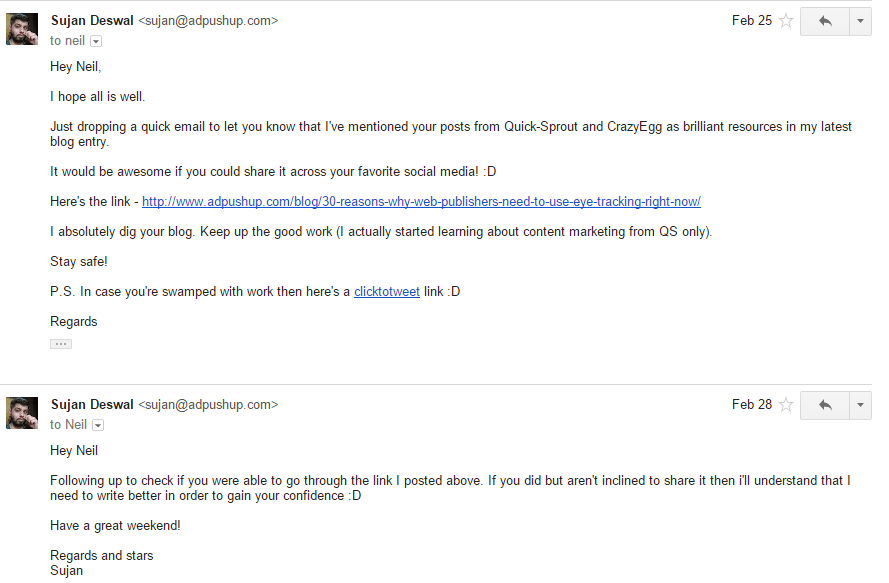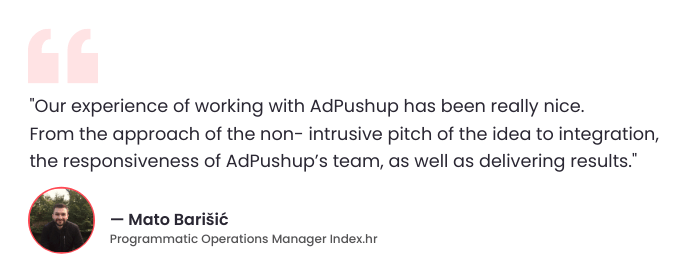So this post is the result of an email conversation I had while helping one of my entrepreneur friends. She is a Product specialist who’s dabbled in PR and wanted to start her current company’s blog (she has been hired as their marketing manager) so when she asked for my advice on how to do that, naturally I obliged.
The text below is 90% exact of what I sent her in the email (yes, I actually wrote such a huge reply). The only changes are that I formatted the post and added links to whoever I mentioned.
So let’s do this.
1. Firstly, here are the 3 things you need to concentrate on (you can’t go wrong with them!) –
#Keyword Research
- Start by making an exhaustive list of keywords that are relevant to your business, from most relevant (which will land your customer directly to your homepage) to closely relevant (close to your niche). Mark down their unique monthly searches and create content around them only. This is an SEO led approach and one which will get you page views and traffic in the long run. It also helps if you can get your post to rank on the first or second page of Google search with quality back-links and such.
#Content
- Create content only keeping in mind – “is this helping someone solve a problem?” and as Moz Founder Rand Fishkin puts it – if you can’t answer the question “who will help amplify this & why?” don’t publish it.
- At AdPushup, our target audience is long form bloggers and web publishers. We write content which either informs them or helps in dealing with a painpoint (e.g. blogging ideas, blogging tips, how to get more subscribers, how to get more traffic, how to increase CTR, among others).
- Publish content at least a minimum of 3 times a week unless it becomes an overload on you. Either that OR write a single brilliant piece that does better than 3 posts (which I feel will be difficult for you right now because it takes experience to write so well. I’m struggling with it too) and concentrate on distributing it like a dog.
- To publish regularly you need content ideas. Content ideas mostly come from –
— Keyword research
— What topics your competitors are writing about
— Evergreen content (guides, tutorials, how-tos, best-practices)
— What the industry experts are tweeting, sharing on social media
— Comments on blogs and from relevant communities
— Round-up posts (“15 Growth Hackers Whose Blog Posts You Should Follow”, “40 Experts Share Their Favorite WordPress Plugins” among others)
- Best practices dictate that the ideal length of a blog post is near 1600 words. In our own efforts, we write posts in the word count range of 1800-3500+ words. I do not follow any metric or data to validate this. I would suggest to not worry about reaching a word count and focus only on providing value. You’ll find that once you do that, your word-count will automatically go up because you’ll want to give your readers the best possible info out there.
- Nail the headline of every post that you publish and you will have won 70% of the battle. If your headline doesn’t inspire confidence, interest, excitement or any sort of emotion then readers wont click on it. Then even though your content might be brilliant and relevant, it will just not get the importance it deserves.
#Distribution
- Write content keeping distribution in mind. This is the most important step because you might be creating phenomenal content but it’s not going to help page-views and traffic if no one is seeing it. I have joined communities on social networks and regularly engage with their members. This helps when you have to share your content there and not come across as a spammer. A cheat sheet on how we currently distribute is –
— Publish content.
— Share on our company’s and our own personal FB, Linkedin, Twitter, Google Plus profiles
— Share on relevant social communities e.g. FaceBook, Reddit, Google Plus, GrowthHackers.com, Inbound.org and if the content is exceptionally written and relevant then HackerNews. [Beware; engage with the community and provide value or you risk being hell banned which is basically ‘game over’ then.]
— Whoever we mention in our post, product or person, we send them or the relevant team members an email telling them about the mention and encourage them to share it on their social media. Most people do actually share if you ask them. Also, it helps if you are relatively well known and the content is really well written. If we do not have an email id, then a Twitter shout out works as well (I have personally never done that but might start soon).
— 3 posts from the week go out as a weekly newsletter to our email subscribers on Tuesday.
— Re-tweeting and re-sharing the content for/after 2-3 days (yes, distribution is a continuous process)
— Pitch it to another site and try to get it re-published.
2. Look for guest posting opportunities because they are an effective way to make your presence in the industry. And guest post only on sites that are relevant to your audience, have a very high volume of traffic and well respected (e.g. HubSpot, KISSmetrics)
3. Influencer marketing is probably what will get you traction vis-a-vis your blog. You need to reach out to them and start being proactive on their blogs, engaging them in the comments section. You can and should email them and ask for their advice regarding a genuine problem. You will soon notice that people are generally nice and are ready to share their knowledge if they have the time. But influencers are busy people so this approach might not always work. So here’s Wikipedia Founder Jimmy Wales advice on how startups should write an email to him if they want a response.
4. Measure everything. Unless you don’t measure, you won’t know what is working and what is not. Always start with a marketing goal/hypothesis in head as to what you’re testing with a post that you’re writing. Meaning you could be testing –
- I’m going to write a post for this Reddit community and see if I get traction from there.
- I’m writing an ‘expert roundup’ post. Let’s see if this gets more shares/page-views/subscriptions than our regular posts.
- I’ll guest post on …. and see if that will get us more shares/page-views/subscriptions
Once you have a sufficient success in measuring ROI – cut out what is not working and concentrate only on what is getting results. And always keep testing and creating hypothesis.
[Right now, we haven’t launched our product so currently our KPI is page-views (basically, traffic). Once we launch, the marketing team’s KPI will change to goal conversions (sign-ups/registrations)]
5. Make sure your email marketing is sorted out. Put pop-up email capture boxes in your blog to encourage visitors to convert into subscribers. I suggest that once you have a decent number of subscribers (300+) and are pushing content out regularly, start rounding them up and email them to your subscribers in the form of a ‘weekly newsletter’.
6. Create buyer persona. It is basically a description of your ideal customer – someone who will directly benefit from your product or service. Creating content around and for them is what will get you more traffic, engagement and a sustainable growth. Here’s Buffer’s guide on the subject.
7. Read a lot – you may or may not be doing this already but I suggest you get after this religiously. The more you learn, the better. Luckily, the current shift in startup content marketing is that founders/core team members are sharing how they reached their goals (which happen to coincide with what you and me are hoping to achieve). E.g. Groove. So basically there is a lot to learn out there. You just need to get started
Q. “What are some of the challenges that I will face with inbound/content marketing ?”
Currently we’re struggling with distribution (which is a very hard nut to crack) and even you will when you start. Other than that,
- Consistently publishing 3-4 pieces of quality content on your blog, if you are new to writing.
- Successfully pitching and getting the opportunity to guest post and then building on that relationship to regularly publish content on that website.
Note: Our Co-founder Ankit Oberoi has guest posted a lot before I joined (on Entrepreneur.com, KISSmetrics, ConversionXL) and he tells me that although our website received traffic from these sources, it was not relevant traffic. So, repeating myself, concentrate only on guest posting on sites which have your target audience. - Finding your target audience and understanding their pain points.
- Deciding which metrics to track to see a return on your efforts.
- Reaching out to influencers. Here’s a post from Inbound.org featuring the best advice I’ve come across to successfully engage influencers.
Q. “Should we outsource our content marketing or do it internally by hiring more people?”
Here I can only share what we are doing and whether it is effective or not.
- I don’t know how efficiently remote teams work but HelpScout does and here’s their post discussing just that.
- We’re a team of two people. Other than that, we have two off-site paid contributors. Once our on-site team has streamlined/automated our operating procedures and have got more adept at handling inbound marketing, we will no longer require the services of the paid contributors. We will then concentrate on getting more traffic, increasing engagement and move on to encourage industry experts/bloggers in our niche to guest post on our blog. But this is a long term goal, so if I were you, I wouldn’t worry about this right now.
Q. “What are some other ways to generate leads and multiply sales?”
- Inbound marketing is the most cost effective way to achieve that. Period.
- On your blog, once you have a good number of posts, do massive internal linking to increase a visitor’s session duration.
- Andrew Chen discusses some tactics that he feels are the only few ways to scale growth and maintain visibility in front of your customers. In case you don’t know who Andrew Chen is then here’s a brief description – He’s a marketing/startup guru and every piece of his advice is gold infused with platinum infused with diamonds infused with more diamonds.
- Since our product hasn’t launched, we are still streamlining how we’ll structure our marketing & sales funnel, among other processes. I’ll write another post on that once the time is right
Q. “What tools are you using for content marketing?”
Right now we’re using –
- WordPress as a Content Management System (CMS)
- Google Drive (docs, sheets) for content creation and sharing
- Trello for content calendar, planning and scheduling
- GetResponse for email marketing
- Hemingway App for grammar and language usage (sometimes)
Q. “How beneficial is inbound content marketing?”
(I believe that if you’re asking this question then it’s prudent to assume that you’re really new to Inbound Marketing.)
Inbound Marketing is the is the single most effective marketing endeavor that you will carry out for your business. It …
- provides for a long term visibility benefit and traffic (SEO articles around targeted keywords will give you traffic for as far as 3-4 years down the line.)
— E.g. We have successfully ranked for the keyword “ppc ad networks“. Our article is first result on the Google search results page and that alone generated 8324 pageviews in March. 7443 in February. 9110 in January.
This post has next to no shares/reactions and yet it is getting us so much of traffic. It was written almost an year back and, organic traffic wise, it’s performing better than any other blog post we have written up till now.
— Google and other search engine’s results account for organic results. Organic means that people came to our website from search engine results and not directly. As of now 67% of AdPushup’s traffic is organic and which is why it is very necessary nail SEO. - it is cost effective
- it is more beneficial than outbound marketing and PR combined
- 90% of the companies are using it to create brand awareness, get relevant traffic and lead generation.
- If your tool/product/service is a car’s engine then inbound marketing is the car (the body, the tyres, the everything). That’s how beneficial and important it is.
Q. “What are the estimated cost of hiring a content marketer?”
Costs for hiring a –
- Rookie content marketer (complete beginner) – 4-5 Lac per annum (INR)
- Amateur content marketer (somewhat experienced) – 6-7 Lac per annum (INR)
- Experienced star – 9-10 Lac per annum (INR)
Q. “What is the traffic on your blog per day? How much has it increased after you and your team started actively updating the blog?”
The average per day traffic currently since the beginning of 2015 is 757 pageviews.
Below is the comparison of traffic with and without inbound marketing (keep in mind, we’ve spent nothing on content marketing)
- June 1 2014 to Dec 1 2014
— Pageviews: 97,433 - Dec 1 2014 to Apr 9 2015
— Pageviews: 154,485 - Difference: +57,042
(We generated much traffic, hurray!)
Q. Which are the channels that help you drive maximum traffic through content?
I’d highly recommend that you look towards Reddit communities. You get mad traffic and shares from there. But you have to post it in a relevant community and also NOT as a plain url link but as a text story, an experience.
Reddit is infamous for being ruthless with spammers and self promoters. So the only way you come across as neither is by providing all the value right there in the community post and add a small link in the end which says something like – “to read the full post, here’s the link” (and provide the exact url, not bitly or any short links). Provide the entire outline right there. Anyone reading it should only click on your post when they know exactly what is in the content and they would still want to read it.
Other than this – (the top reactions we’ve seen community wise are, best to worst)
- Personally emailing people who we have mentioned in the blog.
Here’s the email that I sent Neil Patel –

Note: I had to follow up with him (which is something which most people don’t do with their emails, be it job applications or influencer marketing)
His reaction –

- Google+/Facebook
- Lastly, Linkedin (because we’ve not put in much effort to share it there)
Q. “Some tools that you need to learn in order to be efficient at inbound marketing?”
These are some tools and tips which you have to nail in order to manage your team and grow yourself. Since inbound marketing is all about saving costs, I’m including only those powerful, cost effective tools which you absolutely need to understand. Work on these one by one. As much as I’d like to come across as an expert, I’m not. I too am struggling to learn some of them so that I can perform my job better.
- Google Analytics
- WordPress
— You will need to figure out which WordPress plugins you need in order to make your blog more functional (sharing buttons, pop up email capture boxes, SEO among others) - Google Keyword Planner
- Email marketing tool (how drip emails, autoresponders, newsletters etc. work)

General tips
- Install the extension called ‘Ghostery’ which basically allows you to see what are the tools that a particular site is running. You can use this information to find out if you want similar tools. Here’s an example of how it works (top left corner) –

- I don’t want to be telling you how to do your job but before you hire someone see Simon Sinek’s TED talk.
- Everyone wants to change the world per say but now it has become a euphemism for bulshit in startups. Every startup wants to change the world. The takeaway from this video is not that.
The takeaway is to find out what is the motivation for people to join you? If you can nail the right motivation factor or inspire such thinking like what Simon says then you’re headed towards sure shot success.
It will be extremely difficult to get hold of such kind of people because money is the primary motivation factor amongst our .
— Read this. I strongly believe this article’s applications are not limited to just customer support. When I read this, it confirmed how I personally always felt, is the right way to judge and hire someone.
— Hire inbound marketers not content marketers. Inbound marketing entails that a candidate has to already have content writing skills and he/she has to perform a number of other marketing related tasks other than creating and distributing brilliant content. - Community engagement. Go through this post and see how I’ve replied to everyone and encouraged people to participate.
- Here’s a link to the content SOP (standard operating procedure; read: guidelines on how to write content for new hires) that I made for AdPushup. It is just an illustration of what you can do. It is not perfect but it is a start. I trust that you will only use it to give yourself direction.
- Learn what is link building and how to do it successfully. Look up Brian Dean.
- Here’s an image which contains all the content types that you can generate for your startup (courtesy: Hubspot) –

- Read, read, read, read, read, read and then read some more.
- All of this advice aside, don’t be afraid about failing or not getting it right. My personal work philosophy is to try fail try again, fail, win. You are going to screw up but don’t worry about that. Along with understanding what works, you also have to understand what doesn’t.
Conclusion
I believe that committing to these 3 points is the easiest way to kick-start content marketing. Remember to –
— start with conducting Keyword Research and SEO,
— then move on to creating valuable Content
— and finally, concentrate completely on Distribution
— To get the maximum benefit out of content marketing – Do it consistently. I recommend you start with 2 high quality posts per week and then work your way up to more as you get experienced at writing.
Of course, when you become more proficient at it then you’ll start optimizing all the process for better results. Best of luck!
P.S. Here’s her reply after reading my email. It made my day
P.P.S. And her second reply, after the next wall of text I emailed her, blew me away 

Shubham is a digital marketer with rich experience working in the advertisement technology industry. He has vast experience in the programmatic industry, driving business strategy and scaling functions including but not limited to growth and marketing, Operations, process optimization, and Sales.





